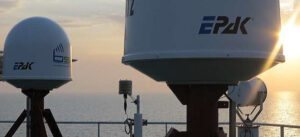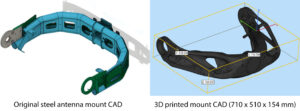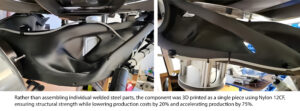Creating custom metal parts is not only costly but also time-intensive. Traditional manufacturing methods often require expensive materials, intricate machining, and weeks of production. But what if you could replace these heavy, labor-intensive components with something just as strong—yet significantly lighter, faster, and far more cost-effective? Enter the world of 3D printing.
In industrial manufacturing, the push for lighter, more efficient, and cost-effective solutions has fueled the shift from traditional metal components to advanced 3D-printed alternatives. EANT GmbH, a leading German engineering firm specializing in automation, recently demonstrated the transformative potential of additive manufacturing (AM) in redesigning maritime satellite antenna mounts.
How 3D Printing Solves the Problem
Additive manufacturing proved to be the perfect solution to bring these innovative designs to life. Using a Stratasys F900® 3D printer and FDM Nylon 12CF, a carbon-fiber-reinforced material, EANT successfully produced antenna mounts that were not only lighter but also met strict structural requirements.
Benefits of using 3D printing for this project:
- Complex Geometry: 3D printing easily fabricated intricate, organic shapes that traditional methods couldn’t achieve.
- Lightweight Materials: Nylon 12CF provided exceptional strength while being significantly lighter than metal.
- Reduced Labor: Additive manufacturing eliminated the need for welding and assembly, streamlining production.
By leveraging 3D printing, EANT achieved extraordinary results:
- 38% Weight Reduction: The redesigned mounts were significantly lighter, enhancing the overall system’s performance.
- 75% Faster Production: Time-to-market was drastically reduced, enabling EANT to deliver results far more efficiently.
- 20% Cost Savings: Lower material and labor requirements made the process much more economical.
Revolutionizing Manufacturing with 3D Printing
This case study showcases how additive manufacturing is reshaping industries by replacing traditional metal components with high-performance 3D-printed parts. The ability to produce highly complex parts quickly, combined with the versatility of materials like Nylon 12CF, is helping manufacturers break barriers in design and production.
Beyond the impressive technical results, 3D printing is enabling businesses to embrace more sustainable practices. With reduced material waste and shorter production times, companies are finding new ways to innovate while cutting costs and environmental impact.
Industries like aerospace, automotive, and maritime are rapidly adopting these technologies to improve efficiency and push the limits of what’s possible in manufacturing.
EANT’s success with additive manufacturing isn’t just about replacing metal—it’s about reimagining what’s possible in manufacturing. 3D printing allows businesses to achieve lighter, faster, and more efficient designs that were previously unattainable with traditional methods.
The future of manufacturing is being built layer by layer. Isn’t it time your business explored the unmatched advantages of 3D printing to transform your processes and stay ahead of the competition?







